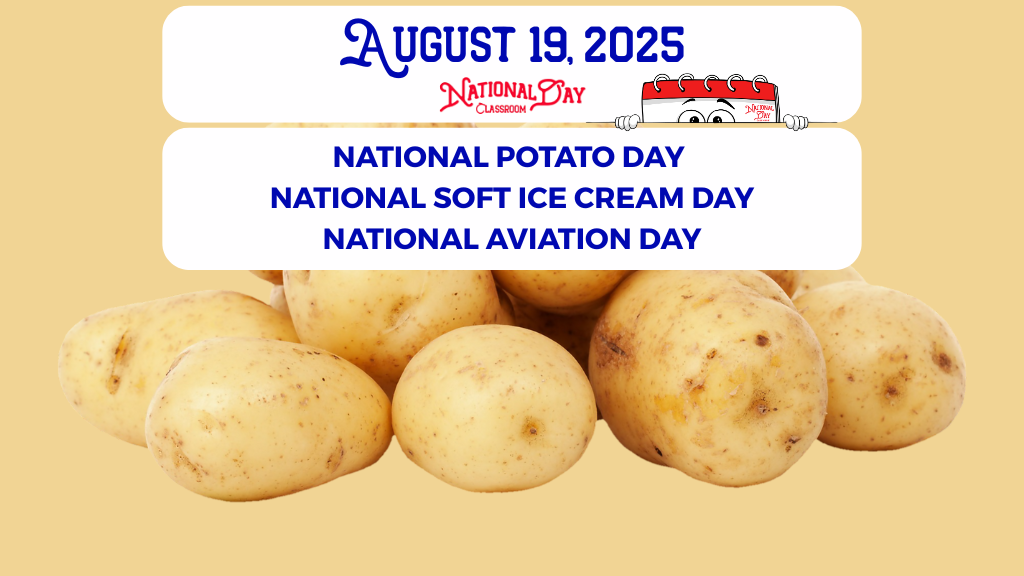
Cal and the Potato Lesson – August 19, 2025
Cal walked into class and noticed something strange sitting on his teacher’s desk.
It wasn’t a pile of books. It wasn’t a stack of papers.
It was… a basket full of potatoes!
“Why are there potatoes on your desk, Mrs. Green?” Cal asked, tilting his head.
Mrs. Green smiled. “Today, class, we’re going to learn about one of the most important foods in history—the potato!”
The whole class giggled. “Potatoes?” said Cal’s friend Maya. “That’s just french fries and chips!”
Mrs. Green held up a large, round potato.
“Actually, potatoes are one of the most versatile foods in the world. People eat them mashed, baked, fried, roasted, boiled—you name it. And did you know they grow underground?”
Cal’s eyes widened. “Wait… they’re like hidden treasure?”
“Exactly!” Mrs. Green said. She passed around some potatoes for the students to hold. Some were small and red, some were big and brown, and one was even purple.
“They come in all kinds of shapes, sizes, and colors,” Mrs. Green explained.
“Potatoes first grew in South America thousands of years ago, and explorers brought them all around the world. Today, farmers grow potatoes on nearly every continent.”
Cal raised his hand. “So… potatoes are kind of like world travelers?”
“Yes!” Mrs. Green laughed. “And they’ve helped feed millions of people through history.”
The class leaned in as Mrs. Green showed a potato sprouting little green shoots.
“If you plant a piece of potato with one of these ‘eyes,’ it can grow into a whole new potato plant.”
“That’s amazing,” said Cal. “It’s like the potato makes more potatoes!”
By the end of the lesson, Cal had learned potatoes weren’t just for eating—they were part of history, science, and farming, too.
As the bell rang, Cal grinned and whispered to Maya,
“I think I’ll never look at french fries the same way again. They’re history on a plate!”
🥔 Lesson Plan: Learning About Potatoes
Grade Level: 2nd–5th
Subject Areas: Science, Social Studies, Math, Language Arts
Time: 45–60 minutes
Learning Objectives
By the end of the lesson, students will be able to:
- Identify the potato as a root vegetable and explain how it grows.
- Describe the history of potatoes and their importance around the world.
- Explore the nutritional value of potatoes.
- Practice observation, sorting, and descriptive writing skills.
Materials Needed
- A few real potatoes (different types if possible: russet, red, sweet, purple)
- Chart paper or whiteboard
- Magnifying glasses (optional)
- “Parts of a Potato Plant” diagram (teacher-prepared or projected)
- Small paper cups, potting soil, and potato pieces (optional planting activity)
- Worksheet/Activity Sheet (sorting, labeling, and writing prompts)
Lesson Outline
1. Hook / Introduction (5 minutes)
- Hold up a potato and ask:
“What is this? Where do you think it comes from?” - Let students share ideas.
- Explain: Potatoes grow underground as tubers and have been important to people all around the world for hundreds of years.
2. Science Connection: How Potatoes Grow (10 minutes)
- Show the diagram of a potato plant.
- Point out: roots, stem, leaves, flowers, and tubers (potatoes).
- Pass around real potatoes for students to observe—notice eyes, skin texture, size differences.
- Optional: Plant potato pieces in small cups with soil so students can observe growth over weeks.
3. History & Geography Connection (10 minutes)
- Share a short story: Potatoes were first grown in the Andes Mountains (Peru/Bolivia) more than 7,000 years ago.
- Spanish explorers brought them to Europe, and eventually they became one of the world’s most common foods.
- On a world map, have students locate South America, then Europe, then the U.S.
4. Nutrition & Math Activity (10 minutes)
- Show a potato nutrition chart (carbohydrates, vitamin C, potassium, fiber).
- Compare a baked potato to a bag of chips—discuss healthy vs. less healthy choices.
- Math tie-in: Weigh two different potatoes. Estimate which is heavier, then check. Graph class results.
5. Language Arts Connection: Potato Writing (10 minutes)
- Writing prompt ideas:
- “If I were a potato, my life would look like…”
- “The journey of a potato from the farm to my plate.”
- “My favorite way to eat a potato is…” (descriptive writing with sensory details).
6. Closing Discussion (5 minutes)
- Ask: “What did you learn today about potatoes?”
- Recap: They grow underground, they’ve traveled the world, they’re healthy to eat, and they’re very versatile.
Extension Ideas
- Art: Potato stamping prints with paint.
- STEM: Try sprouting a potato in water using toothpicks.
- Cooking: Classroom potato tasting—mashed, baked, roasted (if school allows food activities).